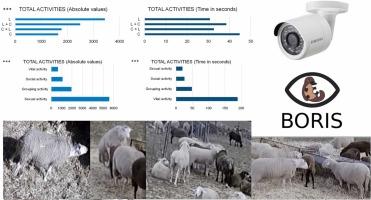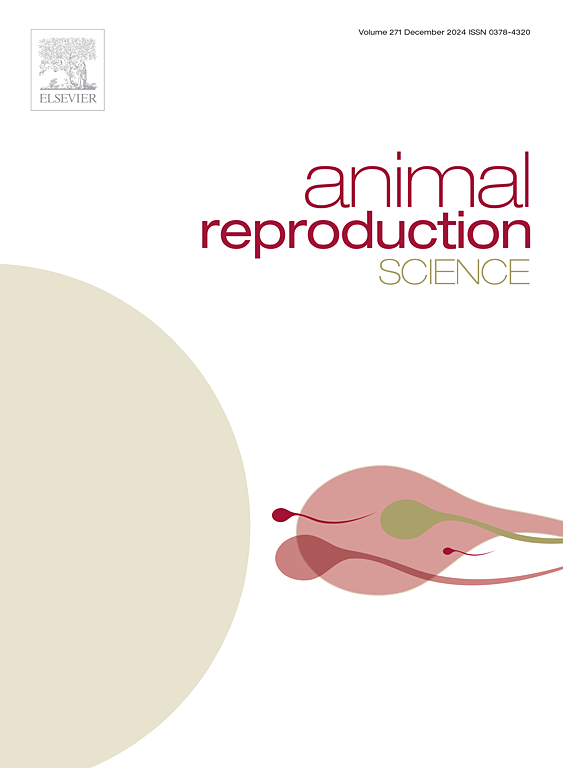Behavioural study of rams subjected to photoperiod change: sexual, social, vital and group activities monitored by video
IF 3.3
2区 农林科学
Q1 AGRICULTURE, DAIRY & ANIMAL SCIENCE
引用次数: 0
Abstract
This study examined behavioural differences in rams exposed to artificial photoperiod stimulation, within the context of the ram effect. Eleven rams were divided into two groups: six received two months of long-day artificial photoperiod (16 h light/day), followed by one month of natural light (9 h light/day, February), while five control rams remained under natural lighting. At the end of the third month, three pens were established: one with photoperiod-stimulated rams (Group L, n = 3), one with control rams (Group C, n = 3), both with 30 ewes, and one mixed pen with both stimulated (Group L+C, n = 3) and control rams (Group C+L, n = 2) with 60 ewes. Behavioural observations were conducted over 11 consecutive days. A total of 26 behaviours-classified as sexual, vital, social, and grouping- were manually recorded and analysed using BORIS software. Sexual behaviours were the most frequent across all groups. Rams in Group L exhibited higher frequencies in all behaviour categories (p < 0.001). Vital activities had the longest durations, with Group C spending more time on these behaviours than others. In the mixed pen, both stimulated and control rams showed intermediate activity frequencies compared to their respective isolated counterparts (Group L: 36.7 % vs. L+C: 26.6 %; Group C: 17.6 % vs. C+L: 19.0 %; p > 0.001).
In conclusion, artificial photoperiod stimulation increased the frequency of key behavioural categories, especially sexual activity. Social interactions in mixed groups modified behaviour, suggesting mutual influence. BORIS software proved valuable for detailed behavioural analysis in ethological research.

受光周期变化影响的公羊的行为研究:通过视频监测性、社会、生命和群体活动
本研究在公羊效应的背景下,研究了暴露于人工光周期刺激的公羊的行为差异。11只公羊被分为两组:6只接受2个月的长日人工光照(16 h光/天),然后是1个月的自然光(9 h光/天,2月),而5只对照公羊仍处于自然光下。第3个月末,建立3个圈,1个圈为光周期刺激公羊(L组,n = 3),1个圈为对照公羊(C组,n = 3),各圈30只母羊,1个圈为光周期刺激公羊(L+C组,n = 3)和对照公羊(C+L组,n = 2),各圈60只母羊。行为观察连续进行了11天。总共有26种行为——分为性行为、生命行为、社会行为和群体行为——被手工记录下来,并使用BORIS软件进行分析。性行为在所有群体中都是最常见的。L组公羊在所有行为类别中表现出更高的频率(p <; 0.001)。重要活动的持续时间最长,C组在这些行为上花费的时间比其他组多。在混合栏中,受刺激的公羊和对照公羊的活动频率与各自隔离的公羊相比都处于中等水平(L组:36.7 % vs. L+C: 26.6 %;C组:17.6 % vs. C+L: 19.0 %;p >; 0.001)。综上所述,人工光周期刺激增加了关键行为类别的频率,尤其是性活动。混合群体中的社会互动改变了行为,表明相互影响。BORIS软件被证明对行为学研究中的详细行为分析很有价值。
本文章由计算机程序翻译,如有差异,请以英文原文为准。
求助全文
约1分钟内获得全文
求助全文
来源期刊

Animal Reproduction Science
农林科学-奶制品与动物科学
CiteScore
4.50
自引率
9.10%
发文量
136
审稿时长
54 days
期刊介绍:
Animal Reproduction Science publishes results from studies relating to reproduction and fertility in animals. This includes both fundamental research and applied studies, including management practices that increase our understanding of the biology and manipulation of reproduction. Manuscripts should go into depth in the mechanisms involved in the research reported, rather than a give a mere description of findings. The focus is on animals that are useful to humans including food- and fibre-producing; companion/recreational; captive; and endangered species including zoo animals, but excluding laboratory animals unless the results of the study provide new information that impacts the basic understanding of the biology or manipulation of reproduction.
The journal''s scope includes the study of reproductive physiology and endocrinology, reproductive cycles, natural and artificial control of reproduction, preservation and use of gametes and embryos, pregnancy and parturition, infertility and sterility, diagnostic and therapeutic techniques.
The Editorial Board of Animal Reproduction Science has decided not to publish papers in which there is an exclusive examination of the in vitro development of oocytes and embryos; however, there will be consideration of papers that include in vitro studies where the source of the oocytes and/or development of the embryos beyond the blastocyst stage is part of the experimental design.
 求助内容:
求助内容: 应助结果提醒方式:
应助结果提醒方式:


